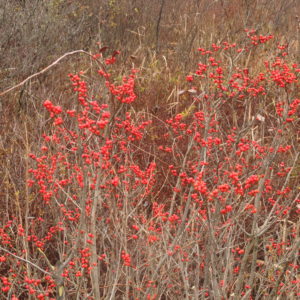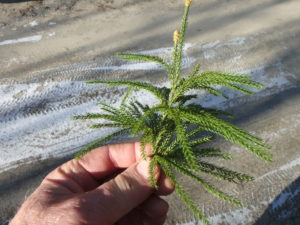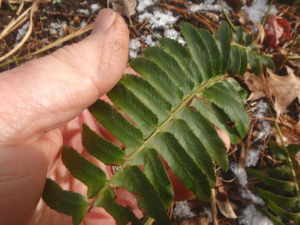Five Plants for Adding Indoor Color
This is the dark time of the year. The sun sets early, and is often obscured by clouds dripping rain and snow. For that reason, I string bright lights on trees outdoors, decorate a tree indoors, place candles in my windows – and lots more. I buy cut flowers, too, but I can’t afford to buy armloads of bright flowers every week. Fortunately the outdoors provides me with many nice things to brighten my living space.
One of my favorite shrubs at this time of year is winterberry (Ilex verticillata). You may have seen the bright red berries of wild winterberry growing alongside the road in wet places, often in standing water. It favors wet places, but can be grown in the average garden. In the wild it is an understory shrub, one that grows in partial shade. It produces the most berries, however, in full sun.
As a landscape plant, the winterberry is best in fall and winter when the red berries are prominent. The spring blossoms are small and white, and hardly noticeable. These shrubs are either male or female, and you need one male for every 6 to 10 females within about a 50-foot range. So when you buy winterberry, plan on having several. Unlike puppies, you can’t lift a tail and know what sex you are buying, but have to depend on the nursery to label them properly.
When you bring cut branches into the house and place them in a vase of water you will notice that they regularly drop berries. There is a solution: spray with a clear lacquer. Last year I sprayed branches that I used on my door wreath, and for the first time ever, most berries stayed on until I took down the wreath. Previously some of the berries fell off every time the door was closed.
Evergreen boughs are commonly used for indoor arrangements, sprays, kissing balls and garlands. If you plan to harvest evergreen branches on your own property for this, be sure to use branches that will hold onto their needles. Balsam fir and spruce, commonly used for Christmas trees, hold onto their needles well even when not in a vase of water. But most of us don’t want to cut off branches if we have balsam or spruce on the property.
What most of us have growing in our woods are white pine and Canadian hemlock. White pines hold their needles, hemlocks do not. The hemlocks have short needles arranged flat along the stems; they have 2 white stripes on the underneath side of each needle. White pine needles are long and pointy, but soft. They grow in bundles of 5 needles (one for each letter in the word ‘white’).
Of the ferns you might see in the woods now, only the Christmas fern (Polystichum acrostichoides) is suitable for use in a vase. These have leathery green leaves with leaflets arranged in an alternating pattern. Some think the leaflets resemble a Christmas stocking, with a toe or heel at the end near its attachment point. I do not. I think they are called Christmas fern because they are still nice at Christmas and other ferns have largely disappeared by now.
Christmas ferns grow in shade or partial shade, and prefer somewhat moist locations. If you pick some, do not completely defoliate an individual plant. Take a few stems from one, and then a few from others. These plants are tough, but slow-growing.
What else is green and will do well indoors? Ground pine (Lycopodium obscurum) grows in deciduous forest in many of the same places as Christmas ferns. It is not a pine at all, but a club moss, a group of primitive plants that fed the dinosaurs when club mosses got to be 30 feet tall. These poor relatives only grow a few inches to a foot tall, but have handsome foliage in winter. They spread by rhizomes or roots. Each plant has leaves that come from the central spine of the plant, and lie parallel to the ground – like little Christmas trees. Please be judicious in picking these.
Back to the reds: red-twigged or redosier dogwood (Cornus sericea), a native of moist areas here in the Northeast, looks good in a vase. The color brightens up considerably in the winter, especially on this year’s growth. If the town road crew brush-hogged the roadside this summer, the new growth on red dogwood will be very bright.
Of course the plant nursery business has been working hard and breeding the reddest, brightest varieties and touting each of them as the very best. But all are good, and are very fast growing – especially in wet areas. I favor pruning out at least half the stems each year to get new stems with bright winter color, and have been known to cut a bush right to the ground.
So don’t feel bad if you can’t afford big vases of roses at this time of year. Get outside and pick some nice things that will brighten the house.
Read Henry’s blog at https://dailyuv.com/





